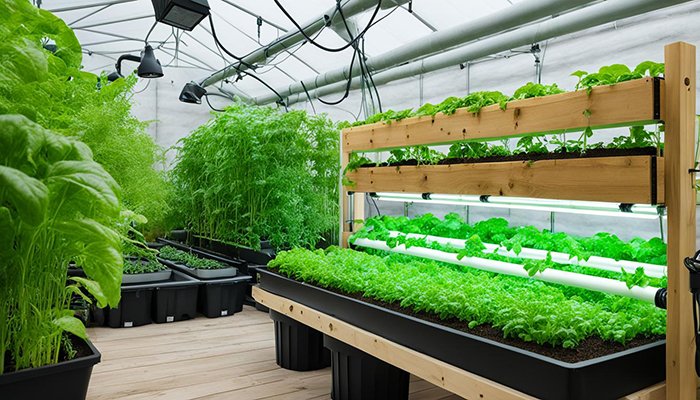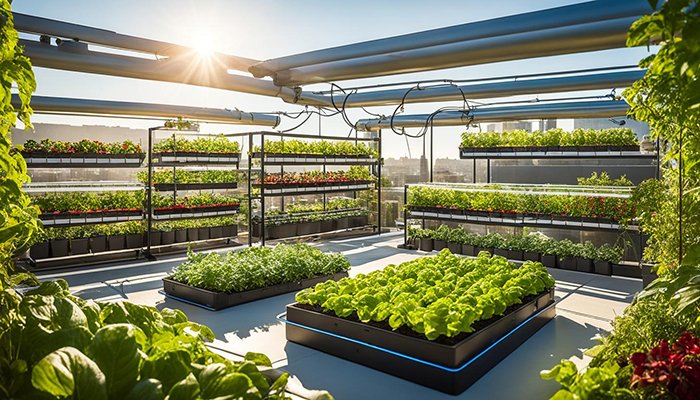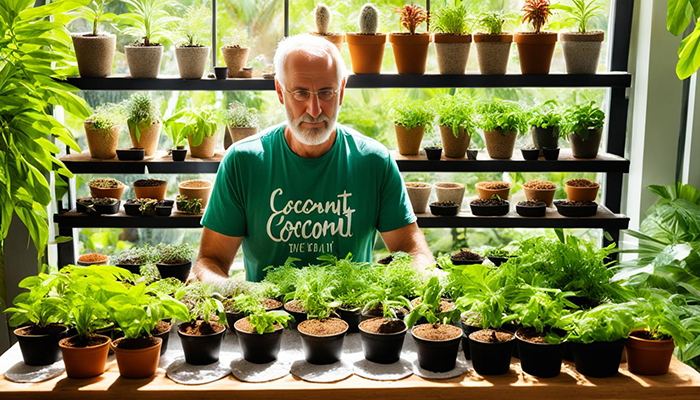Welcome to my guide on outdoor hydroponic gardening! I’m here to share some tips and tricks to help you grow greens efficiently and create a thriving garden. Hydroponic gardening is an innovative method of growing plants without soil, allowing you to cultivate herbs and vegetables year-round, even with limited outdoor space. With the right knowledge and equipment, you can achieve impressive results and enjoy a bountiful harvest. Let’s dive in!
Table of Contents
Advantages of Outdoor Hydroponic Gardening
I absolutely love outdoor hydroponic gardening because it offers numerous advantages over traditional soil-based gardens. Let me share with you some of the key benefits that make hydroponic gardening the perfect choice for outdoor enthusiasts like me!
Outdoor hydroponic gardening provides the perfect balance of nutrients and water, which results in faster and healthier plant growth compared to traditional soil gardens.
The use of natural sunlight in outdoor hydroponic gardens eliminates the need for artificial lighting. This not only saves energy but also ensures that plants receive the full spectrum of light they require for optimal growth.
One of the greatest advantages of outdoor hydroponic gardening is that it requires less water compared to traditional gardening methods. This makes it a more water-efficient option, which is essential for conserving this precious resource.
Furthermore, outdoor hydroponic gardens are not susceptible to weeds, as the plants are grown in a controlled environment without any soil. This makes maintenance a breeze and minimizes the use of herbicides or manual weeding.
Overall, outdoor hydroponic gardening offers a host of advantages, including faster growth, healthier plants, water efficiency, and ease of maintenance. It’s a fantastic way to enjoy the beauty of nature while reaping the rewards of bountiful harvests!
Check out the following table to see a comparison between outdoor hydroponic gardening and traditional outdoor gardening:
| Advantages | Outdoor Hydroponic Gardening | Traditional Outdoor Gardening |
|---|---|---|
| Faster Growth | Plants grow faster due to optimal nutrient and water availability. | Growth is slower due to variable nutrient and water availability in the soil. |
| Healthier Plants | Plants thrive in a controlled environment, resulting in healthier plants with fewer diseases. | Plants may be more susceptible to diseases and pests due to soil conditions. |
| Water Efficiency | Requires significantly less water compared to traditional gardening. | Water consumption is higher due to evaporation and soil absorption. |
| Maintenance | Minimal maintenance required due to absence of weeds and controlled growing conditions. | Regular weeding and soil maintenance are necessary. |
As you can see from the table, outdoor hydroponic gardening offers distinct advantages that can enhance your gardening experience and yield remarkable results. With faster growth, healthier plants, and water efficiency, you can enjoy a thriving garden while minimizing your impact on the environment.
Essential Equipment for Outdoor Hydroponic Gardening
When it comes to outdoor hydroponic gardening, having the right equipment is essential for a successful and thriving garden. Here are the key items you’ll need:
1. Hydroponic System
A hydroponic system is the heart of your outdoor garden. It provides a controlled environment for your plants to grow without soil. Whether you choose a simple deep water culture setup or a more advanced system, ensure that it meets the size and requirements of your garden.
2. Water Basin
A water basin is where the nutrient-rich water for your plants is stored. It acts as a reservoir, providing a constant supply of water and essential nutrients. Make sure the basin is large enough to accommodate your plants’ needs.
3. Lighting
Lighting is crucial for photosynthesis, which is necessary for plant growth. You can utilize natural sunlight if you have a sunny outdoor location, or you can opt for artificial grow lights. Ensure that your plants receive the right amount and quality of light throughout the day.

4. Temperature Control
Controlling the temperature is important to create optimal growing conditions for your plants. Maintain the recommended temperature range by providing shade, ventilation, or using cooling techniques such as adding cool water to the system.
5. Grow Trays
Grow trays are used to support your plants and provide a raised surface. They help with water drainage and prevent the saturation of the growing medium. Choose trays that are suitable for the size and type of plants you are growing.
6. Fertilizer or Nutrients
Just like plants grown in soil, hydroponic plants need a nutrient-rich environment to thrive. Choose a suitable fertilizer or nutrient solution that provides all the essential elements required for healthy plant growth.
7. Growing Medium
Instead of soil, hydroponic gardening uses a growing medium to support the plant’s roots. Examples of suitable growing mediums include Rockwool, which is made from superheated rock and chalk, and coco coir, which is a byproduct of coconut husks. Select a growing medium that suits your plants’ needs and allows for adequate root aeration.
By investing in the essential equipment for outdoor hydroponic gardening and properly setting up your system, you’ll create an ideal environment for your plants to flourish and yield a bountiful harvest.
Tips for Setting Up Your Outdoor Hydroponic System
When setting up your outdoor hydroponic system, there are several key factors to consider to ensure optimal conditions for your plants to thrive. By following these tips, you can set up your hydroponic garden for success.
1. Choose a Location with Southern Exposure
Maximize sunlight exposure for your outdoor hydroponic system by choosing a location that receives ample southern exposure. This will provide your plants with the necessary light for photosynthesis and promote healthy growth.
2. Maintain Cool Water Temperature
Keep the water temperature in your reservoir cool to provide optimal conditions for your plants. You can achieve this by adding cold water to the system or providing shade to prevent excessive heating. Maintaining a suitable water temperature helps to prevent stress on your plants and ensures their well-being.
3. Monitor and Adjust EC Levels
The EC (electrical conductivity) levels of your nutrient solution need to be carefully monitored and adjusted to meet the specific needs of your plants. EC levels affect the availability of essential nutrients, so regularly test the nutrient solution and make necessary adjustments to provide the optimal balance for your plants’ growth.
4. Promote Proper Air Movement
Ensure proper air movement in your outdoor hydroponic system to prevent stagnant air and promote healthy plant growth. Take advantage of natural breezes by positioning your garden where there is good airflow. You can also provide wind protection, such as using fences or windbreaks, to maintain a steady flow of fresh air.
5. Implement Effective Pest Control Measures
Pest control is crucial for maintaining a healthy outdoor hydroponic system. Prevent insects and animals from damaging your plants by implementing effective pest control measures. This can include using natural deterrents, installing physical barriers, or introducing beneficial insects that prey on pests.
“By following these tips, you can create an outdoor hydroponic system that provides optimal conditions for your plants to thrive and grow healthily.”
By carefully considering these tips when setting up your outdoor hydroponic system, you can create an environment in which your plants can flourish. With proper placement, temperature control, nutrient balance, air circulation, and pest protection, your hydroponic garden will be set up for success.

Choosing the Right Growing Medium for Outdoor Hydroponics
When it comes to outdoor hydroponics, selecting the appropriate growing medium is essential for the success of your garden. Different plants have different needs, and the right growing medium can provide the necessary support and adequate nutrient delivery. Below are some common options:
| Medium | Description |
|---|---|
| Rockwool | A popular medium made from superheated rock and chalk. Provides excellent water retention and allows for optimal root development. |
| Coco Coir | A byproduct of coconut husks. Retains water well, provides good aeration, and is environmentally friendly. |
| Hydroton | Lightweight expanded clay pebbles. Promotes excellent root oxygenation and drainage. |
| Perlite | An expanded ore with good oxygen retention. Lightweight and helps with root aeration and drainage. |
| Pumice | A porous volcanic rock that provides excellent drainage while retaining some moisture. Ideal for cacti and succulents. |
| Gravel | A small rock that is inexpensive and drains well. Suitable for plants that prefer drier conditions. |
Each growing medium has its advantages and disadvantages. Consider factors such as water retention, root support, and drainage when choosing the right medium for your plants. Experimentation and understanding your plants’ requirements will guide you in selecting the optimal growing medium for your outdoor hydroponic garden.

Maintaining the Optimal Conditions for Outdoor Hydroponics
To ensure the success of your outdoor hydroponic garden, it is important to maintain the optimal conditions. By following these essential tips, you can create an environment that allows your plants to thrive and grow efficiently.
Sunlight
One of the key factors for the success of outdoor hydroponics is providing your plants with sufficient sunlight. Place your garden in an area that receives at least 6-8 hours of direct sunlight each day. If your garden is shaded, consider using reflective materials or mirrors to redirect sunlight towards the plants.
Water temperature
The water temperature plays a crucial role in the growth and development of your hydroponic plants. It is important to monitor and regulate the water temperature to keep it within the recommended range. Most plants thrive in water temperatures between 65°F and 75°F (18°C and 24°C). Use a reliable water thermometer to regularly check the temperature and make adjustments if necessary.
Nutrient levels
Proper nutrient levels are essential for the health and growth of your plants. Regularly monitor the nutrient levels in the water and adjust them according to the specific requirements of your plants. Maintain a balanced nutrient solution with adequate levels of essential minerals and trace elements.
Air circulation
Adequate air circulation is vital for preventing mold and promoting healthy plant growth. Make sure there is proper airflow around your plants by using fans or creating natural air channels. This helps to avoid stagnant air and ensures that carbon dioxide is readily available for the plants’ photosynthesis process.
Pest management
Implement effective pest management strategies to protect your plants from pests and diseases. Regularly inspect your garden for signs of pests and take appropriate measures to control them. Use organic pest control methods such as beneficial insects or organic sprays to avoid harmful chemical residues in your crops.
By maintaining the optimal conditions for your outdoor hydroponic garden, you can maximize the productivity and quality of your crops. Remember to regularly monitor sunlight, water temperature, nutrient levels, air circulation, and implement effective pest management strategies to ensure the health and vitality of your plants.
Types of Outdoor Hydroponic Systems
When it comes to outdoor hydroponic gardening, there are several types of hydroponic systems to choose from. Each system has its own unique features and benefits, allowing you to customize your gardening experience. Let’s explore some of the most popular outdoor hydroponic systems:
1. Vertical Hydroponic Systems
Vertical hydroponic systems are ideal for those with limited space. These systems utilize vertical structures to maximize growing area while minimizing the footprint. By stacking plant trays vertically, you can grow more plants in a smaller space. Vertical hydroponic systems are commonly used in urban environments and allow for efficient use of space in small gardens and balconies.
2. Aquaponics Systems
Aquaponics systems combine hydroponic gardening with fish farming, creating a self-sustaining ecosystem. Fish waste provides natural fertilizer for the plants, while the plants filter the water for the fish. This symbiotic relationship between fish and plants allows for the growth of both healthy crops and fish. Aquaponics systems are an excellent choice for those interested in sustainable gardening practices.
3. Simplified Systems
Simplified hydroponic systems, such as flood and drain and floating bed systems, are commonly used in developing countries due to their simplicity and low cost. These systems require manual circulation and aeration, making them more accessible to individuals with limited resources. Simplified systems are a great starting point for beginners in hydroponic gardening or those looking for budget-friendly options.
No matter which outdoor hydroponic system you choose, it’s important to consider your gardening goals and available resources. Each system has its unique advantages and is suited to different environments. Experiment with different systems to find the one that works best for you.
Now, let’s take a look at a comparison table outlining the key features and requirements of each system:
| System | Space Requirement | Resource Efficiency | Complexity |
|---|---|---|---|
| Vertical Hydroponic Systems | Small footprint, maximizes vertical space | High resource efficiency | Moderate complexity |
| Aquaponics Systems | Medium footprint, requires space for fish tank | High resource efficiency | Moderate complexity |
| Simplified Systems | Small to medium footprint | Variable resource efficiency | Low complexity |
As you can see from the table, each system has its advantages in terms of space requirement, resource efficiency, and complexity. Consider these factors when choosing the right system for your outdoor hydroponic garden.
With a variety of outdoor hydroponic systems to choose from, you can find the perfect fit for your gardening needs. Whether you opt for vertical hydroponics, aquaponics, or simplified systems, you can enjoy the benefits of efficient and sustainable gardening. Happy hydroponic gardening!
Conclusion
Outdoor hydroponic gardening is a game-changer for plant enthusiasts. It offers numerous benefits, such as faster and healthier plant growth, water efficiency, and the ability to grow food in urban areas with limited space. By incorporating hydroponic gardening techniques into your outdoor setup, you can create a successful garden that provides you with fresh produce all year round.
Following essential tips for setting up and maintaining your outdoor hydroponic system is key. Choose the right growing medium, set up the optimal conditions, and implement effective pest management strategies to ensure your plants thrive. Experiment with different hydroponic systems to find what works best for your specific needs.
With outdoor hydroponic gardening, you have the power to cultivate a thriving garden, even in the smallest of spaces. Embrace the benefits, apply the tips, and watch your garden flourish with healthy and delicious crops. Get ready to enjoy the rewards of successful outdoor hydroponic gardening!
FAQ
What is hydroponic gardening?
Hydroponic gardening is a method of growing plants without soil. It uses nutrient-rich water instead of soil to provide plants with the necessary nutrients for growth.
Can hydroponic gardening be done outdoors?
Yes, hydroponic gardening can be done both outdoors and indoors. Outdoor hydroponic gardening allows for natural sunlight to provide the necessary light for plant growth.
What are the advantages of outdoor hydroponic gardening?
Outdoor hydroponic gardening offers faster and healthier plant growth compared to traditional soil gardens. It also saves water and eliminates the need to deal with weeds.
What equipment is needed for outdoor hydroponic gardening?
The essential equipment for outdoor hydroponic gardening includes a hydroponic system, water basin, lighting, temperature control, grow trays, fertilizer or nutrients, and a suitable growing medium.
How do I set up an outdoor hydroponic system?
When setting up your outdoor hydroponic system, choose a location with southern exposure for optimal sunlight. Monitor and regulate the water temperature, maintain proper nutrient levels, ensure adequate air circulation, and implement pest control measures.
What growing medium should I use for outdoor hydroponics?
Common options for growing mediums in outdoor hydroponics include Rockwool, coco coir, hydroton, perlite, pumice, and gravel. Each medium has its pros and cons, so choose the one that suits your plants’ needs and gardening setup.
How do I maintain optimal conditions for outdoor hydroponics?
To maintain optimal conditions for outdoor hydroponics, ensure sufficient sunlight, regulate water temperature, monitor nutrient levels, promote air circulation, and implement effective pest management strategies.
What types of outdoor hydroponic systems are available?
There are various types of outdoor hydroponic systems, including vertical systems, aquaponics systems that combine hydroponics with fish farming, and simplified systems such as flood and drain or floating bed systems.
What are the benefits of outdoor hydroponic gardening?
Outdoor hydroponic gardening offers faster plant growth, water efficiency, and the ability to grow food in urban areas with limited space. By following the essential tips and setting up and maintaining an outdoor hydroponic system, you can create a successful garden that provides fresh produce all year round.
You might also be interested in:
Gardening Advice : Click Here

